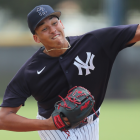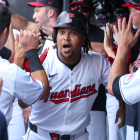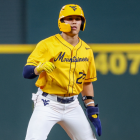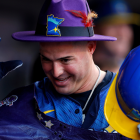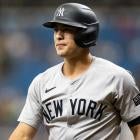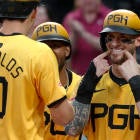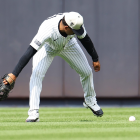In the most eventful trade deadline day in franchise history, the Texas Rangers pulled off two major trades, and cemented themselves as one of the favorites to win the World Series. Still, the most emblematic moment of the day for the ballclub didn't happen in their board room, or even during a Rangers game. It happened at Wrigley Field.
Starting for the Cubs against the Marlins, right-hander Kyle Hendricks went the distance, tossing his second career shutout. That sparkling outing lowered Hendricks' ERA to 2.22, the third-lowest mark in the majors, behind only three-time World Series winner Madison Bumgarner and Clayton Kershaw, the best pitcher on the planet. What made the moment so quintessentially Rangers was Hendricks' background. An eighth-round pick in the 2011 draft by Texas, Hendricks got flipped a year later to the Cubs in a trade for veteran Ryan Dempster.
The move, of course, flopped. Dempster never did much for Texas, while Hendricks has grown into a top starter for the best team in the National League. But the biggest takeaway here isn't that general manager Jon Daniels and his talented staff made a trade that failed; as we will see, they've made several terrible moves over the past few years, ones that might torpedo lesser franchises. Instead, the real lesson here is this: The Rangers have become such a prolific talent-producing machine, they can make multiple ugly trades, still have more than enough young talent to fill the major league roster, then have even more left to pull blockbuster, potentially league-altering deadline deals, like the ones they made on Monday.
The highlight deal of the day saw the Rangers snag All-Star catcher Jonathan Lucroy and hard-throwing closer Jeremy Jeffress. Lucroy is in the middle of an excellent season, batting .299/.359/.482, while throwing out 40% of would-be basestealers. Add in plus pitch-framing skills and good subjective marks for less quantifiable defensive tasks, and Texas just landed one of the best all-around catchers in the game, someone who's a huge upgrade over the so-so defenders who combined to hit just .233/.287/.422 this year. In Jeffress, the Rangers land a third right-hander (to go with closer Sam Dyson and middle man Matt Bush) who fires fastballs into the high-90s. As with Dyson, Jeffress's heat generates relatively modest strikeout totals (18.4 percent K rate this year), but also a ton of groundballs (57.7 percent groundball rate).
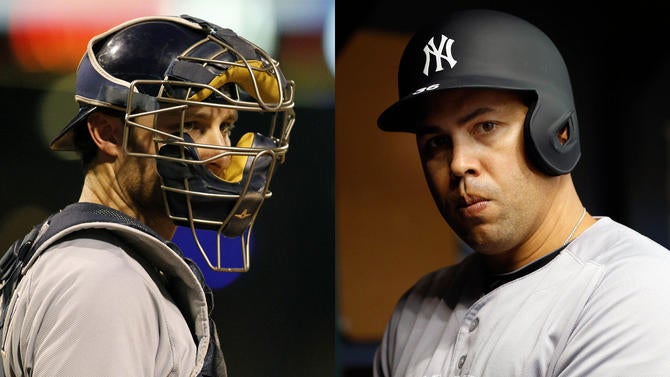
Meanwhile, Texas also acquired Carlos Beltran from the Yankees. Enjoying his best season in five years, Beltran's batting .304/.344/.546, ranking among the AL leaders in homers and slugging average. At age 39, Beltran's one of the worst defensive outfielders in the game, which is no problem for the Rangers, who'll use him to DH with Prince Fielder out for the season. What made those trades even more fascinating is the list of players Texas gave up... and didn't give up. For weeks, we'd heard that the Rangers wanted to aggressively upgrade their big league roster, but also wanted to do so without giving up impressive young position players Nomar Mazara, Jurickson Profar, or Joey Gallo. Despite teams' repeated calls to land one or more members of that trio, Texas held firm, and got their big deals done anyway.

They did so because of the seemingly bottomless pool of young talent that the team has built over the past few years. To land Lucroy and Jeffress, the Rangers gave up Lewis Brinson, the Rangers' first-round pick four years ago who's an ace outfield defender with a chance to hit for big power, rated the no. 16 prospect in the game or better by Baseball America, Baseball Prospectus, and MLB.com heading into this season. Also going to Milwaukee in the trade: right-hander Luis Ortiz, a player who recently made ESPN.com writer Keith Law's midseason top-50 prospects list. For two-plus months of Beltran (plus potential playoff at-bats), Texas gave up Dillon Tate, a rangy right-handed starter whose velocity has slipped this year, but also the number-four overall pick in the draft just a year ago. Those moves follow the recent acquisition of Lucas Harrell for Travis Demeritte, yet another first-round pick who just gained increased national attention playing in the Futures Game.
All three of those trades happened within a week and a half of each other, costing Texas three former first-round picks in all. But we can trace the story of the Rangers' prospect overload back much further than that.
As Rangers writer and Newberg Report proprietor Jamey Newberg explained, the deal that started the whole cycle happened before the 2010 deadline, when Texas traded four young players to land lefty ace Cliff Lee. The signature player in that trade was Justin Smoak, the sweet-swinging first baseman who at the time was considered roughly the equivalent to what Gallo is now -- a top-flight prospect with major offensive upside. Lee was a major contributor to that 2010 club, and a driving force in their playoff run.
But what's more amazing are the many trades that flopped after that one. In 2012, they sacrificed Hendricks to get Dempster. In 2013, they have up future successful big league relief pitchers Justin Grimm and Carl Edwards for a couple months of mediocre Matt Garza. A few months after the Garza deal, they slipped Ian Kinsler to Detroit for Prince Fielder, a trade that now looks impossibly awful, with Kinsler dominating for the Tigers and Fielder looking like he might be on his last legs, while still being owed tens of millions of dollars. Those deals followed the stinker July 30, 2011 trade with the Orioles, which saw Chris Davis and Tommy Hunter flipped to Baltimore for Koji Uehara.
All those trades failed, and multiple other players have failed to live up to expectations, during the Rangers' current run of near-perennial playoff contention. Yet time and time again, new players emerge and produce. Last year, it was an in-season bullpen turnaround, one that saw the lightly regarded Dyson emerge as a key set-up man, complementing waiver pickup Shawn Tolleson's evolution into the team's closer. This year, it was Profar stepping up to play multiple positions; the rookie Mazara taking over in right due to injuries; and right-hander A.J. Griffin acquired for nothing over the winter, evolving into a decent back-of-the-rotation starter.
Of course, many of the Rangers' prospects never make it to the big club in Arlington, instead getting sent to other teams to consummate big trades. Such was the case both in the recent spate of three deals, and of course last summer's blockbuster move for impact left-handers Cole Hamels and Jake Diekman. Even more striking is how deep you can dive into the Rangers system to find prospects other teams want. Outfielder Nick Williams was considered a second-tier prospect by Texas standards, righty Jared Eickhoff a half-notch below that, yet the Hamels-Diekman deal doesn't happen without them. Meanwhile, Hendricks, Edwards, and now-Nationals right-hander Tanner Roark were all ostensibly third-tier prospect options in the Rangers system who've found success with other clubs.
Newberg listed off some of the behind-the-scenes talent evaluators and coaches who helped make that cavalcade of talent thrive. Credit goes to everyone from A.J. Preller (former head of pro and international scouting, and assistant GM) to Josh Boyd (head of pro scouting); Scott Servais (former farm director) to Mike Daily (current farm director); Danny Clark (minor league pitching coordinator) to Josue Perez (minor league hitting coordinator), and of course Daniels, assistant GM Thad Levine, and many more. The most telling number uttered by a GM today might have been Daniels citing 32 at Monday's post-deadline press conference. As in, other teams talking to Texas asked for 32 different Rangers prospects over the few weeks leading into the deadline.
The Rangers still have some question marks on the roster, starting with a rotation that features a combination of injury risks and performance risks, from staff ace Yu Darvish all the way down to the fifth starter Harrell. But Texas also owns the best record in the American League, despite suffering through a lousy 11-15 showing in July. More importantly for the long haul, they still wield one of the top collections of young talent in the game, even after shipping out three recent first-round picks this year, and a bevy of other prospects before that.
Texas has a real shot to win the World Series this year, something that's never happened in franchise history. As long as the talent machine keeps cranking, a bunch more chances could follow...even if the Rangers end up failing this time around.










